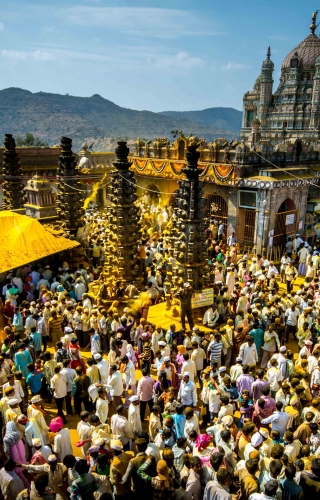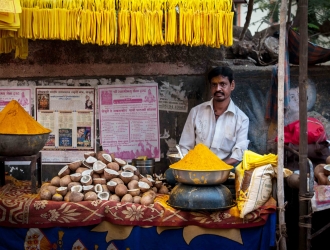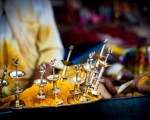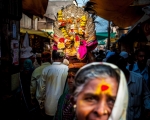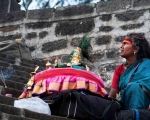The cult of Khandoba is popular throughout Maharashtra, the Konkan region, Telangana, Andhra Pradesh, and northern and central Karnataka. There are more than 600 temples dedicated to Khandoba in the Deccan region, but the principal one is at Jejuri, located 48 km from Pune in Maharashtra. Jejuri’s Khandoba is the kuldevta (family or clan deity) of a number of nomadic, agricultural and hunting communities, and various merchant, warrior and brahmin castes. Khandoba is also venerated by Muslims, who call him Mallu Khan, and by the Jains and Lingayats.
Jejuri is the site of the Somvati Amavasya festival, a six-day festival, observed from the first to the sixth lunar day of the bright lunar fortnight in the month of Margashirsha of the Hindu calendar. The Somvati festival, as the name suggests, falls on a somvar (Monday) and is dedicated to the worship of Surya (sun god). During the festival, pilgrims apply haldi powder on each other, painting the town a bright shade of yellow—the Golden Jejuri. Haldi is usually used as a flavouring agent in South Asian cuisines or for dyeing purposes, but during this festival, the colour of haldi is associated with the luminosity of Surya, suggestive of Khandoba’s solar origin.
When I first got to know about the Golden Jejuri, I was curious as I had never heard of any festival which was celebrated with turmeric. I set out to cover the festival in December 2013. My sister-in-law and I drove from Mumbai to Pune, where we stayed overnight and started for Jejuri at 6:00 am next morning. It took us about three hours to reach Jejuri. Leaving our car behind, we started on foot for the hill that houses the Khandoba Temple. The climb consists of 450 steps and the way is lined by shops selling souvenirs and ritual items. Many pilgrims who had walked long distances carrying the image of their kuldevta were also climbing up to the temple with us.
When we reached the temple, it was teeming with devotees, all soaked in turmeric powder. The main temple enclosure consists of a mandapa (audience hall), a garbhagriha (sanctum sanctorum) and a central courtyard lined with four large stone deepa stambhas (lamp towers). Among the various activities taking place in the courtyard, I was most intrigued by the spectacle of men flagellating themselves; by coming out of it unharmed, the devotees believe they are temporarily connected to the divine, thus making them immune to the stimuli of pain. Self-flagellation is also a means of purifying one’s soul or an act of penance for a sin they might have committed.
At other places pilgrims were performing rituals or singing devotional songs. The musicians who gather during the festival are an integral part of the cult of Khandoba and they are called Waghyas, meaning tiger. Historically, the Waghyas were bards entrusted with passing down the myths associated with Khandoba in the form of stories, poems and songs of bhakti.
After some time, a group of men brought out the main idol of Lord Khandoba on a palki. Devotees thronged around the palki for darshan and to seek Khandoba’s blessings. One of the trustees, with whom I had a chance of a brief interaction, informed me that at around 4:00 pm the palki would be taken to the nearby Karha River for the ritual bathing of the idol and carried back to the temple at night.
I climbed to the roof for a better view of the procession before it started its journey to the river. Below I could see a sea of pilgrims drenched in yellow, hailing loudly 'yelkot yelkot jai malhar' ('victory to Malhar, worshipped by six crore devotees'), a salutation to Khandoba who is also known as Malhari or Mallari, meaning the slayer of the demon Malla. The palanquin moved slowly, given the number of people, and it would take several hours for it to reach the Karha River at the base of the hill. I did not wait to observe the return journey as it was getting dark, but this was one of the most exciting experiences in my career as a photographer.
The festival, however, is unique given its highly inclusive traditions, bringing together various communities and castes. Khandoba is venerated in many forms—as a tribal god, as Shiva in his Bhairava form and Surya in his form as Marthanda. Similarly, his many wives associate Khandoba with various agricultural, hunter-gatherer and pastoral communities; his wives are also venerated as avatars of Parvati, Shiva’s consort. As a result, he is worshipped by communities like the Matangs and Mahars, who belong to the lower castes, the Dhangars, who are nomadic tribes, and also by the Gauda Saraswat Brahmins and Deshastha Brahmins belonging to the higher castes. Again, Khandoba is also worshipped in observance of his marriages to his two main wives, Mhalsa and Banai, or for his position as a fertility god, in anticipation of a good harvest, protection of livestock or the boon of a child in the family.
This aspect of how folk gods and local fertility cults are integrated into the larger pantheon of Hinduism is a feature that occurs throughout the Deccan. Khandoba’s popularity cutting across caste barriers is a result of the assimilation of practices, mythologies, icons and rituals from a multitude of belief systems and philosophical traditions prevalent in the Deccan region, and in this syncretism lies Khandoba’s true significance.
Further Reading
Sontheimer, Günther-Dietz, Anne Feldhaus, Aditya Malik, Heidrun Brückner. 1997. King of Hunters, Warriors, and Shepherds: Essays on Khaṇḍobā . New Delhi: Indira Gandhi National Centre for the Arts.
